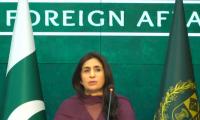CM Murad urges irrigation department to
manage situation, give priority to potable water
Sindh’s chief minister said on Monday that water shortage in the kharif season was likely to be between 10 and 60 per cent, directing the irrigation department to evolve a strategy to deal with the situation and give priority to providing potable water.
Syed Murad Ali Shah presided over a meeting at the CM House on Monday to discuss the expected water shortage during the upcoming kharif season.
The meeting was attended by Chief Secretary Rizwan Memon, CM’s Principal Secretary Naveed Kamran Baloch, Irrigation Secretary Syed Jamal Shah and other relevant officers and engineers.
Secretary Shah told the chief executive that water availability in the Indus basin was found to be below the allocated discharge since March 9. “The situation has worsened with the new spell of snowfall in the northern areas and the lowering of the temperature.”
He said the run-off from the catchments had reduced, which resulted in the alarming depletion in the Tarbela and Mangla reservoirs, adding that the indent of Sindh at the Chashma Barrage in March 2, 10-daily was 40,000 CFS against which 22,798 CFS was the total flow of the downstream Chashma. “This includes Punjab’s requirement of the canals off-taking from the Taunsa Barrage.”
The secretary said the water shortage had started on March 18 with 10 per cent and was expected to rise up to 60 per cent in the first 10-daily of April, adding that the present situation had a trend similar to that of 2012, with the hope that the snowfall this year was more than that of 2012.
“The complication is the abrupt fall in Skardu’s temperature. IRSA has informed that if the melting of snow and rainfalls are delayed, the situation may further aggravate and can extend to the end of April.”
CM Shah reminded the irrigation secretary that he had asked him to convene a meeting with chief engineers of all the three barrages and discuss a way forward.
Secretary Shah told the chief executive that he had held a meeting with the chief engineers and the optimum strategy had been devised: on March 31 there would be a scheduled yearly closure of the Guddu Barrage. “Until that time the pond level will be lowered and maintained at RL 249 for supplying water to Balochistan (1,000 CFS), the power station and Ghotki Canal (1,000 CFS).”
He added that on April 1 the barrage gates would be fully raised and water would be released completely to downstream. “Total withdrawals of the Sukkur Barrage will be 10,100 CFS during the shortage.”
The irrigation secretary said that on the right bank NWC & Dadu Canal would be closed on March 31 under the scheduled closure. “Balochistan’s share in March 3, 10-daily from the Sukkur Barrage right bank is 700 CFS, which will be ensured up to March 31. However, NWC & Dadu Canal are reduced proportionately.”
He said Khairpur Feeder East and West would be released 650 CFS each (-50 per cent), adding that Rohri Canal would be operated in three groups and would receive 5,000 CFS. “Nara Canal will also be operated in two groups and will receive 3,800 CFS.”
Secretary Shah told the meeting that from the Sukkur Barrage 3,000 CFS would be released for the Kotri Barrage. “The allocation of Kotri Barrage during March 3, 10-daily is 4,000 CFS. With the improvement of flows at Sukkur, priority will be given to the Kotri Barrage to meet its drinking water needs and early kharif requirements.”
He said that during April 1, 10-daily the Kotri allocation was 6,500 CFS. On this the chief minister directed the irrigation department to immediately inform the public about the shortage of water. “This should also be disseminated that the priority is assigned to drinking water needs.”
CM Shah said the late sowing of crop should also be publicised for cotton from May 1 for the Nara and Rohri canals and May 15 for the Ghotki Canal. “For the pedi/rice cultivation, after observing the situation at the end of April, a fresh strategy may be formed to facilitate Khatedars of rice canal commands.”
He said the adjustment in the canal discharge to manage the shortage should be made after consultation and advice of the relevant chief engineers. He added that the Kotri Barrage would receive water proportionately, but “priority should be assigned to drinking water needs of the canal commands off-taking from the barrage”.
Secretary Shah said that almost all the canals had to bear 50 per cent shortage in the supply of water, but the province was already experienced in dealing with such a situation.
He said that the operation of Keenjhar Lake would be optimised to cater for the maximum period of time for supplying water to Karachi.
The chief minister directed the irrigation department to issue an advisory to the Karachi Water & Sewerage Board to make use of water within the city taking into account the shortage of flows in all rivers and the existing shortage within the lake.
An aerial view of Karachi city. — AFP/FileCelebrating ShakespeareThe National Academy of Performing Arts is...
This representational image shows a woman touching a dead body's legs. — APP/FileThe woman killed on Wednesday in...
The University of Karachi entrance gate. — APP/FileThe role of educated mothers is crucial for the development of...
Secretary Information Department Nadeem-ur-Rehman Memon. — Facebook/Umerkot - Gateway to TharSecretary Information...
Commissioner Karachi Syed Hasan Naqvi chairs a meeting to assess the preparations for the upcoming 29th International...
Sindh’s chief secretary Syed Asif Hyder Shah chairs a meeting with the National Highway Authority on April 18,...







